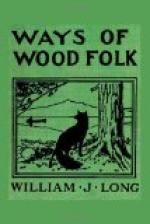I learned the wisdom of this advice in connection with the first snowy owl I had ever met outside a museum. I surprised him early one winter morning eating a brant, which he had caught asleep on the shore. He saw me, and kept making short flights from point to point in a great circle—five miles, perhaps, and always in the open—evidently loath to abandon his feast to the crows; while I followed with growing wonder and respect, trying every device of the still hunter to creep within range. That was the same owl which I last saw at dusk, flying straight out to sea among the gulls.
[Illustration: A CHRISTMAS CAROL]
XIV.
The Christmas carol, sung by a chorus of fresh children’s voices, is perhaps the most perfect expression of the spirit of Christmastide. Especially is this true of the old English and German carols, which seem to grow only sweeter, more mellow, more perfectly expressive of the love and good-will that inspired them, as the years go by. Yet always at Christmas time there is with me the memory of one carol sweeter than all, which was sung to me alone by a little minstrel from the far north, with the wind in the pines humming a soft accompaniment.
* * * * *
Doubtless many readers have sometimes seen in winter flocks of stranger birds—fluffy gray visitors, almost as large as a robin—flying about the lawns with soft whistling calls, or feeding on the ground, so tame and fearless that they barely move aside as you approach. The beak is short and thick; the back of the head and a large patch just above the tail are golden brown; and across the wings are narrow double bars of white. All the rest is soft gray, dark above and light beneath. If you watch them on the ground, you will see that they have a curious way of moving about like a golden-winged woodpecker in the same position. Sometimes they put one foot before the other, in funny little attempt at a dignified walk, like the blackbirds; again they hop like a robin, but much more awkwardly, as if they were not accustomed to walking and did not quite know how to use their feet—which is quite true.
The birds are pine-grosbeaks, and are somewhat irregular winter visitors from the far north. Only when the cold is most severe, and the snow lies deep about Hudson Bay, do they leave their nesting places to spend a few weeks in bleak New England as a winter resort. Their stay with us is short and uncertain. Long ere the first bluebird has whistled to us from the old fence rail that, if we please, spring is coming, the grosbeaks are whistling of spring, and singing their love songs in the forests of Labrador.
A curious thing about the flocks we see in winter is that they are composed almost entirely of females. The male bird is very rare with us. You can tell him instantly by his brighter color and his beautiful crimson breast. Sometimes the flocks contain a few young males, but until the first mating season has tipped their breast feathers with deep crimson they are almost indistinguishable from their sober colored companions.




